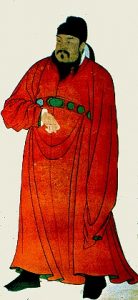
A T’ang Dynasty emperor
In 220 AD, Han Dynasty China fell apart into three medium-sized kingdoms, so people call this the Three Kingdoms period. In 581 AD, a general named Wen Ti managed to conquer the other two kingdoms and created a new Chinese empire under the Sui dynasty. Wu Ti’s son, Yang Ti, dug a big canal to connect the Yellow River with the Yangtze River. But Yang Ti was killed in 618 AD, and the next rulers began the T’ang Dynasty.
Under the T’ang dynasty, China’s cities grew bigger, and taxes and trade were better organized. China got bigger and bigger, much bigger than it is today. But then a series of civil wars weakened the T’ang. In 960 AD, the Song Dynasty took over ruling China. They had a lot of trouble fighting off invaders from Central Asia. Traders began to sail south to India, instead of using the Silk Road. By 1279 AD the Mongols invaded from Central Asia and conquered China.
The Mongols ruled China as the Yuan dynasty, under Kublai Khan. The Mongols did a good job, ruling from China all the way across Central Asia, India, and West Asia and into Eastern Europe. But by the 1330s, people all over the Mongol empire were dying of the plague, and the Mongol empire fell apart.
In China, the Ming Dynasty took over from the Mongols, and finally China was an independent empire again. The Ming emperors brought back many of the old traditions, but late medieval China also kept the new ideas brought by the Mongols.
[…] Medieval China – History […]